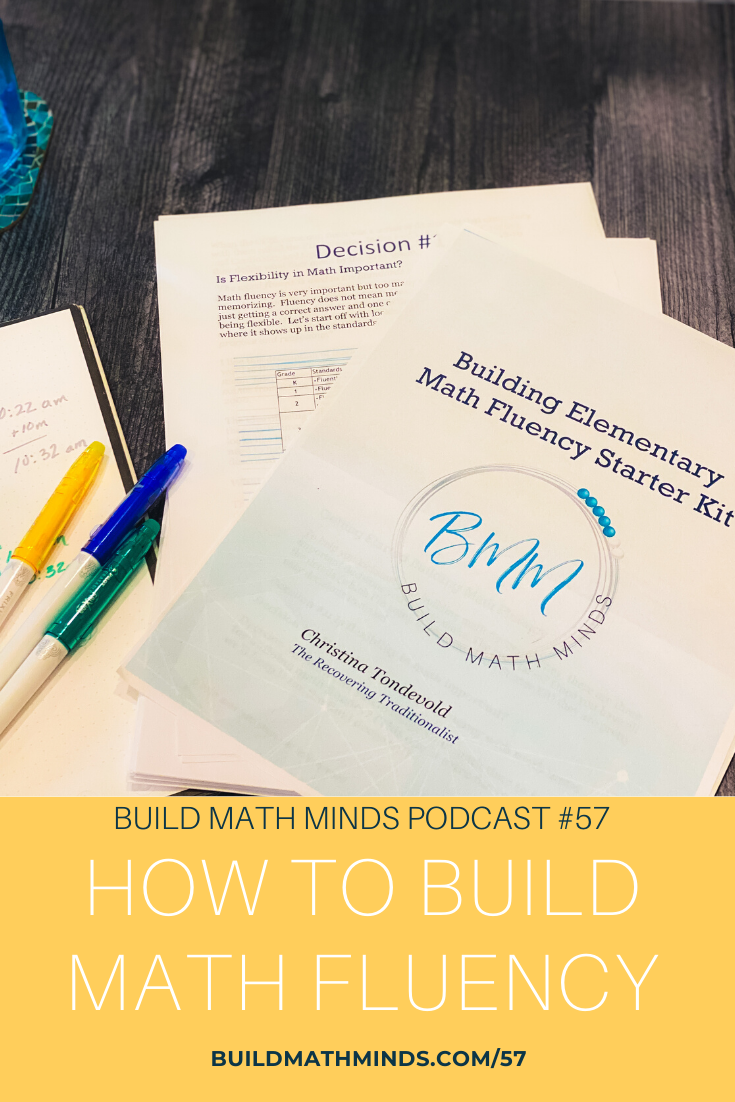Resources mentioned in this episode:
Get your Building Math Fluency Kit
Building Math Fluency video series (and you can also request the kit on that page)
Welcome fellow Recovering Traditionalists to Episode 57. Today we are looking at How to Build Math Fluency.
Right now we are in the middle of trying to juggle this whole online/distance learning. But so much of it is out of our control. You can’t control what your state or district asks you to do. It’s frustrating, but focusing on the things that we can’t control is futile. Believe me there have been days I just want to lay in bed all day, have my 4 kids fend for themselves, and just watch Netflix all day. But that serves nothing.
When I feel like that, I push out the thoughts about the stuff I can’t control and focus on the things I can control.
One thing I have focused on is creating a new, free resource for all you elementary educators. At first I wasn’t sure if I would release it or not right now. But, I decided to because this resource can help you get clear on how to help your kids in math…whether you have them physically in your classroom or not.
So if you are wanting to learn some things about how to help your students build their math fluency now, in this online setting, or if you want to start planning how to help your kiddos when they get back into your classroom, the Building Math Fluency Starter Kit will help you out.
Building kids’ math fluency can impact everything they are going to learn in math. It all starts with understanding what fluency really entails, how to build that fluency when it comes to the basic facts, and what kinds of activities you can be doing to build true fluency for students. That’s what you will get in the Building Math Fluency Starter Kit. To get yours go to buildmathminds.com/fluencykit.
I’m going to read a section from the kit for today’s podcast.
On page 3 it says
“The term fluently (or ‘with fluency’) shows up in the Common Core State Standards (CCSS) in every grade from Kindergarten through 6th Grade. I know that not everyone uses the CCSS, so check your own state standards but I’m sure they will be very similar if not the same.
So with every grade having some sort of ‘fluency’ standard, and even a couple that say ‘know from memory,’ it’s no wonder we are all concerned about it. But ‘know from memory’ and ‘memorize’ are not the same thing. When you are truly fluent in something you know it from memory but that isn’t the same as memorizing something.”
And that’s all I’m going to give you. I know it’s a little annoying, but I want you to go get your hands on this Fluency Starter Kit and read the information for yourself. I go into detail about what it means and what it looks like to know from memory versus what it means and looks like to memorize.
So head over to buildmathminds.com/fluencykit to request your copy of the Building Math Fluency Starter Kit.
I also have a free video series about Building Math Fluency that you can find a link to over on the show notes page. The videos go into more detail about the stuff I share in the Fluency Starter kit. They are meant to help you so that you will be ready to hit the ground running when you get students back in your classroom, or if you are teaching right now this kit and video series will give you some ideas on things to make sure you focus on to ensure their mathematical foundation is solid.
Again, I know so much of what you have to do right now as a teacher is out of your control but I want to encourage you to look towards the future for when you get students back in your classroom. You will have control over what happens when they come back and I want to help give you some ideas through that video series and fluency kit.
Stay safe and stay mentally healthy.
These episodes are sponsored by the online trainings that I do for elementary educators. I have online number sense courses that thousands of teachers have gone through. Number Sense 101 is for Prek-2nd grade educators and Number Sense 201 is for 3rd-5th grade educators. These courses help you understand the foundation of number sense, how it impacts students’ ability to become fluent in mathematics, and how to help your students build their number sense. Registration for the courses will be opening soon. Go to buildmathminds.com/enroll to learn more about each course.
Subscribe and Review in iTunes
Hey, are you subscribed to the Build Math Minds Podcast, yet? If you’re not, make sure to do that today because I don’t want you to miss any episodes! Click here to subscribe to the podcast in iTunes.
While you’re there, don’t forget to leave a review on iTunes too. I would love to know your thoughts and how we can make sure that we give you content that you will really enjoy.
To leave a review, head over to iTunes and click on “Ratings and Reviews” and “Write a Review.” I can’t wait to hear your thoughts about the podcast.





Thank you Christina! I have been struggling to create a “flow” in my life now that I am out of the classroom. I do get up, drink my coffee, and have my devotions. I am so excited to get your resource. My main struggle is how to transfer this type of thinking to my parents. Any suggestions?
You are amazing! Thank you so much for your generosity, your genuine care and words of wisdom and encouragement.